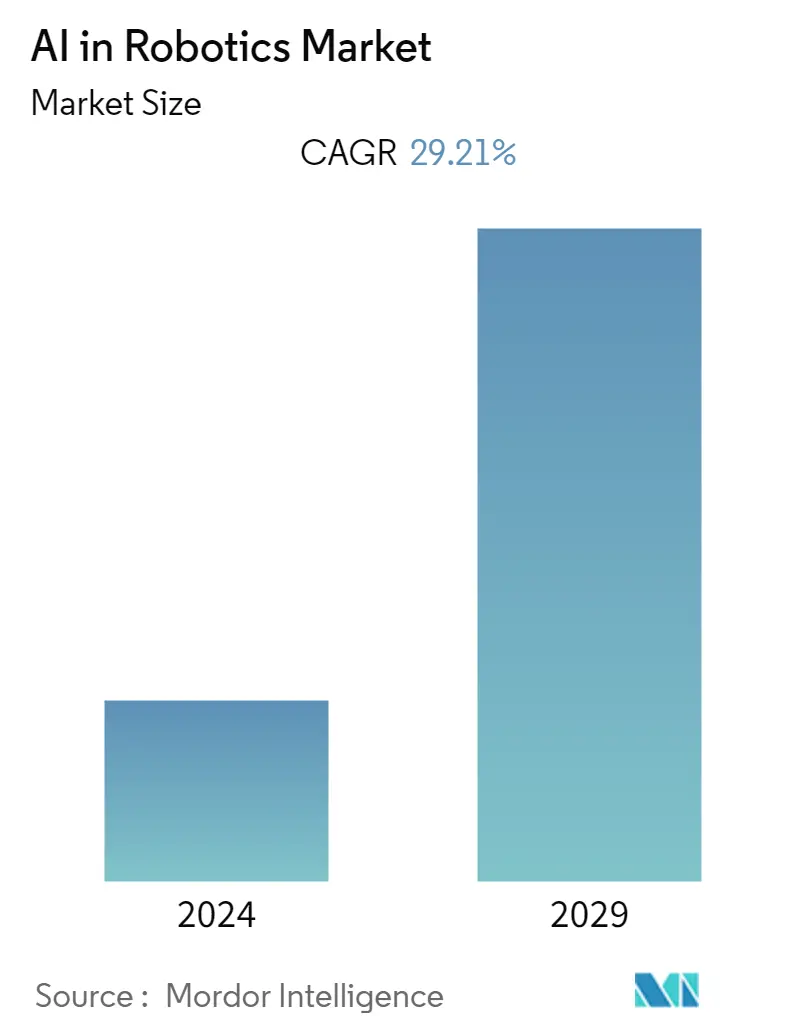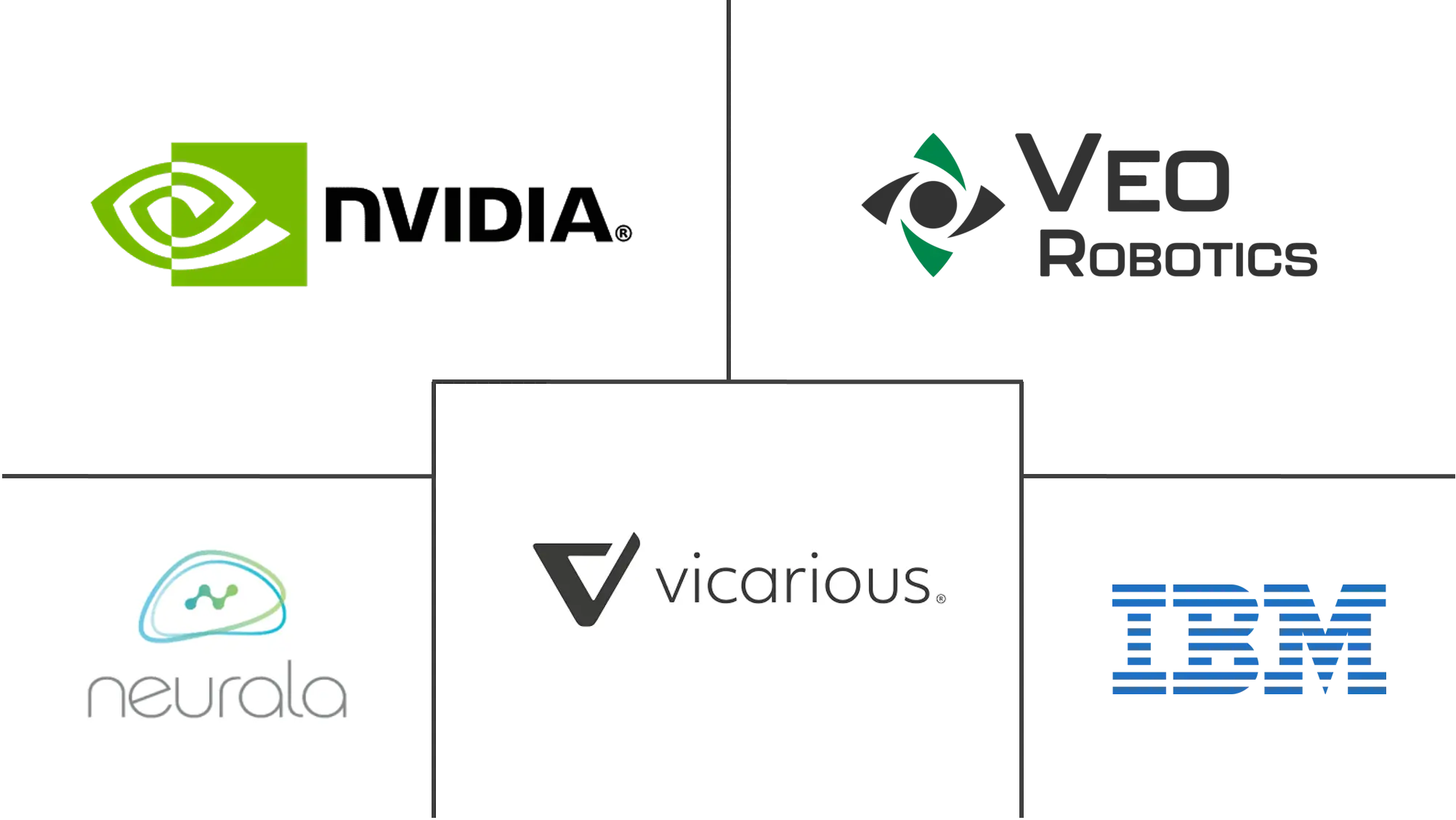Market Size of AI in Robotics Industry

| Study Period | 2021 - 2029 |
| Base Year For Estimation | 2023 |
| CAGR | 29.21 % |
| Fastest Growing Market | Asia-Pacific |
| Largest Market | Asia-Pacific |
| Market Concentration | Medium |
Major Players
*Disclaimer: Major Players sorted in no particular order |
Artificial Intelligence in Robotics Market Analysis
Artificial Intelligence in the robotics market is expected to register a CAGR of 29.21% during the forecast period. Artificial intelligence (AI) and robotics prove to be a powerful combination for automating tasks and processes. AI in robotics gives flexibility in operations and enables robots with learning capabilities in various applications. Artificial intelligence in robots offers companies new opportunities to increase productivity, make work safer, and save people valuable time.
- Integration of robotics and AI augments and amplifies human potential, increases productivity, and moves from simple reasoning to human-like cognitive abilities. The next stage of artificial intelligence is the era of "augmented intelligence," which seamlessly links humans and machines together.
- Robots are designed to perform repetitive tasks with utmost precision and increased speed. AI in robotics helps the robots learn the processes and perform the functions with complete autonomy, without any human intervention. These benefits are expected to augment market growth.
- Also, higher adoption rates of robots in almost all the end-user verticals, coupled with support from governments worldwide to develop modern technologies, are undoubtedly significant factors augmenting the market's growth. However, a reluctance to adopt technological developments is expected to slow market growth. Also, a lack of a skilled workforce to adopt the integration of AI in robotics is hindering market growth.
- However, the lack of experts with the necessary knowledge and expertise to operate AI robots will prevent their widespread adoption across various industries. In addition, the absence of appropriate regulations in this industry would reduce its demand globally. Companies in sectors with the lowest labor costs are gradually implementing AI robots.
Due to rising automation technology demand as well as the growing use of AI robots in the medical sector to control COVID-19, the market for artificial intelligence (AI) robots has grown dramatically in recent years. Due to its ability to handle the complexity of massive data and provide high accuracy and quick processing solutions, artificial intelligence (AI) is being used to advance science and technology. Due to the increased demand for automation in the manufacturing, automotive, and industrial sectors in the post-COVID-19 period, businesses are assessing the long-term income potential of AI robots.
Artificial Intelligence in Robotics Industry Segmentation
Artificial intelligence in robotics refers to the seamless integration of robots with artificial intelligence (AI) technology. These robots learn to perform a few repetitive tasks that can be done without any human intervention and can even communicate with humans or, in some cases, with other robots.
The Artificial Intelligence in Robotics Market is segmented by Robot Type (Industrial Robots, Service Robots), End-User Industry (Automotive, Retail & Ecommerce, Healthcare, Food & Beverage), and Geography (North America, Europe, Asia-Pacific, and Rest of the World).
The market sizes and forecasts are provided in terms of value (in USD million) for all the above segments.
| By Robot Type | |
| Industrial Robots | |
| Service Robots |
| By End-user Industry | |
| Automotive | |
| Retail & E-commerce | |
| Healthcare | |
| Food & Beverage | |
| Other End-user Industries |
| Geography | |
| North America | |
| Europe | |
| Asia-Pacific | |
| Rest of the World |
AI in Robotics Market Size Summary
The integration of artificial intelligence (AI) in robotics is transforming industries by enhancing automation capabilities and improving operational efficiency. This synergy allows robots to perform tasks with greater precision and speed, while also enabling them to learn and adapt to new processes autonomously. The adoption of AI in robotics is driven by the need for increased productivity, safety, and time-saving solutions across various sectors. However, challenges such as a lack of skilled workforce and reluctance to embrace technological advancements may hinder market growth. Despite these challenges, the demand for AI-driven robots is rising, particularly in sectors like manufacturing, automotive, and healthcare, where automation is becoming increasingly essential.
The market for AI in robotics is experiencing significant growth, fueled by advancements in technology and the increasing need for automation in industries worldwide. North America stands out as a leading region in adopting these technologies, with a strong focus on warehouse automation and material handling. The automotive, food and beverage, and pharmaceutical sectors are major contributors to the demand for industrial robots in this region. As robots become more sophisticated, with capabilities like real-time environmental perception and natural language processing, their adoption is expected to rise. The competitive landscape is becoming fragmented, with numerous vendors seeking to capitalize on the opportunities presented by AI and robotics. Companies are investing in research and development to drive innovation and expand their global presence, further propelling market growth.
AI in Robotics Market Size - Table of Contents
-
1. MARKET DYNAMICS
-
1.1 Market Overview
-
1.2 Market Drivers
-
1.2.1 Government Support to Develop Modern Technologies
-
1.2.2 Higher Adoption Rates of Robots in all End-user Verticals
-
-
1.3 Market Restraints
-
1.3.1 Reluctance to Adopt New Technologies
-
1.3.2 Lack of Skilled Workforce
-
-
1.4 Industry Value Chain Analysis
-
1.5 Industry Attractiveness - Porter's Five Forces Analysis
-
1.5.1 Bargaining Power of Suppliers
-
1.5.2 Bargaining Power of Buyers/Consumers
-
1.5.3 Threat of New Entrants
-
1.5.4 Threat of Substitute Products
-
1.5.5 Intensity of Competitive Rivalry
-
-
1.6 Technology Snapshot
-
1.6.1 Natural Language Processing
-
1.6.2 Computer Vision
-
1.6.3 Navigation
-
1.6.4 Machine Learning
-
-
-
2. MARKET SEGMENTATION
-
2.1 By Robot Type
-
2.1.1 Industrial Robots
-
2.1.2 Service Robots
-
-
2.2 By End-user Industry
-
2.2.1 Automotive
-
2.2.2 Retail & E-commerce
-
2.2.3 Healthcare
-
2.2.4 Food & Beverage
-
2.2.5 Other End-user Industries
-
-
2.3 Geography
-
2.3.1 North America
-
2.3.2 Europe
-
2.3.3 Asia-Pacific
-
2.3.4 Rest of the World
-
-
AI in Robotics Market Size FAQs
What is the current AI in Robotics Market size?
The AI in Robotics Market is projected to register a CAGR of 29.21% during the forecast period (2024-2029)
Who are the key players in AI in Robotics Market?
Vicarious AI, Neurala, Inc., Veo Robotics, Inc., NVIDIA Corporation and IBM Corporation are the major companies operating in the AI in Robotics Market.

